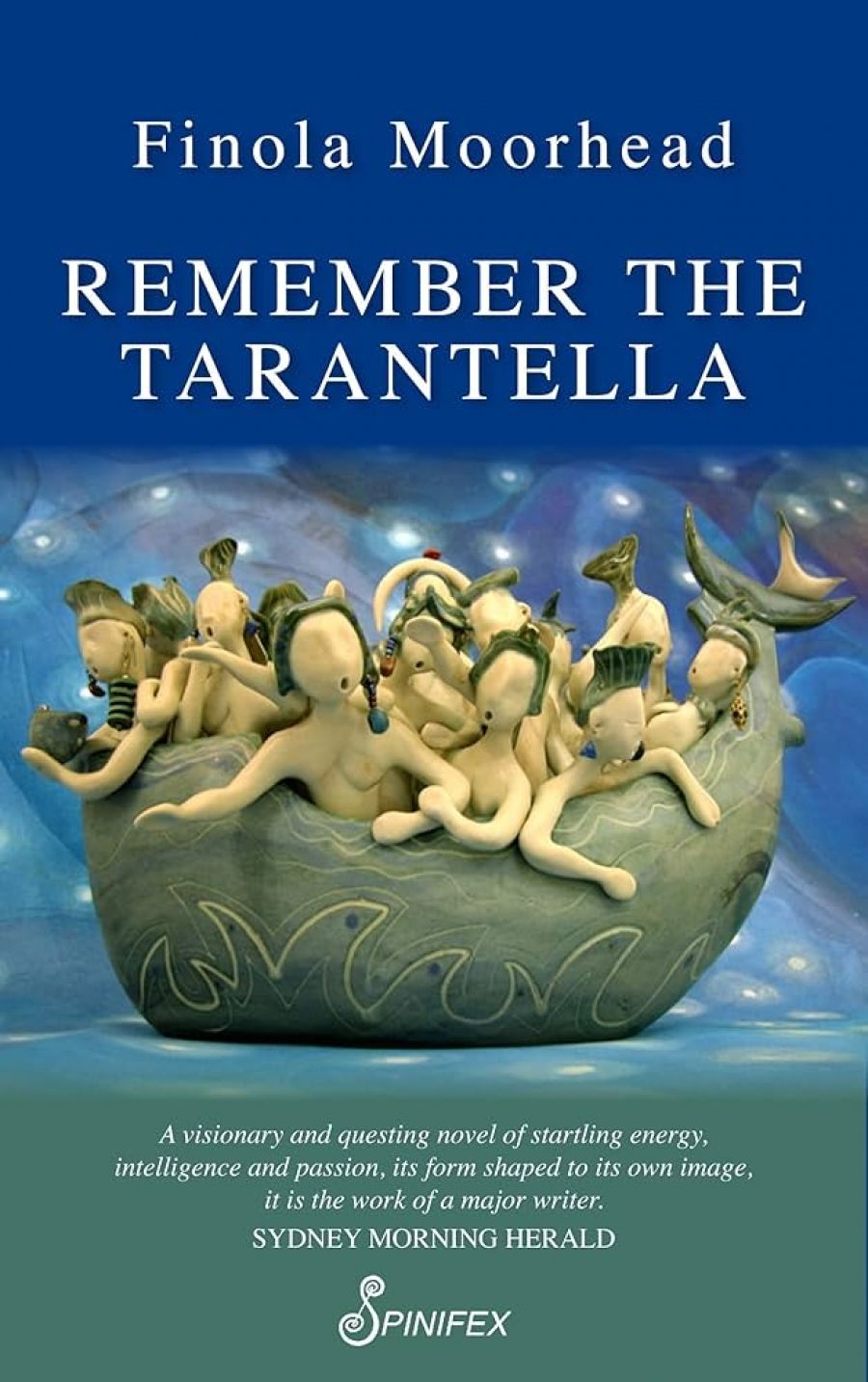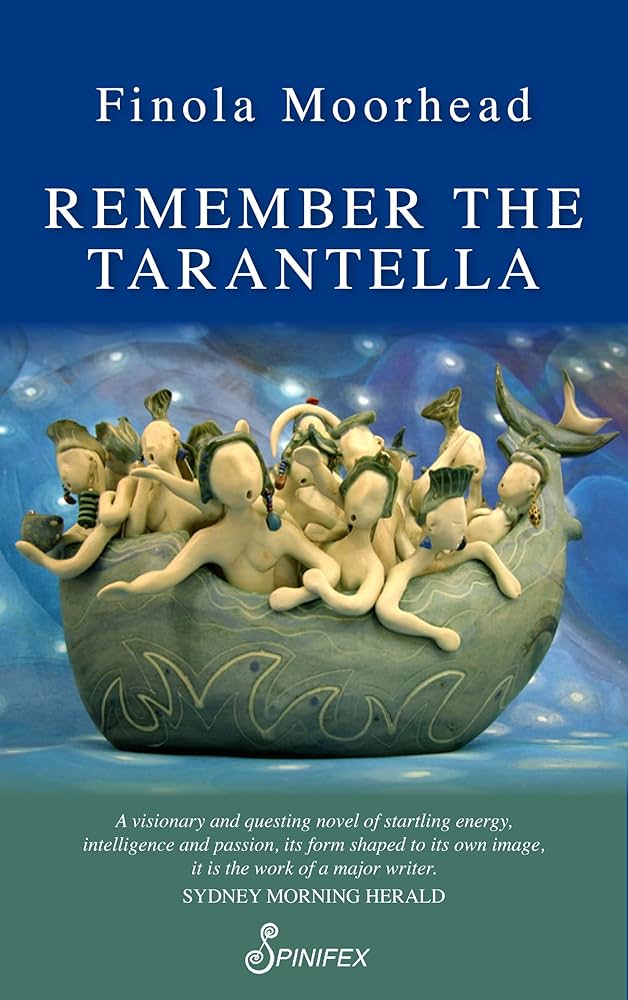
- Free Article: No
- Contents Category: Feminism
- Review Article: Yes
- Article Title: ‘The combi never gets there!’
- Online Only: No
- Custom Highlight Text:
A dense, experimental, postmodern, lesbian-feminist novel, Remember The Tarantella will be referred to by future generations as a landmark in Australian literary history. The book is not without problems, but in language and form it attempts to recover and recreate women’s history and culture and by doing so, challenges notions of a singular, dominant authorial voice, plays with narrative expectation and demands at all times the active participation of its reader.
- Book 1 Title: Remember the Tarantella
- Book 1 Biblio: Primavera Press, $24.95 pb, 350 pp
- Book 1 Cover Small (400 x 600):

- Book 1 Cover (800 x 1200):

Moorehead’s earlier book, Quilt (a ‘patchwork’ of short stories, poetry and critical writings), shows the concern of the author for patterns and intricacies. In Remember the structure is carefully woven into a spiral of action which spins a fine web across the globe. The central character is a Melbourne taxi driver (the spider) who drives (under the moon) through the night streets of Melbourne while the women who makeup her community move between the squats of England, the prisons of the Middle East, Spain, Italy, Paris, Amsterdam and the back seat of her cab. They are connected by letters, gossip, thoughts, dreams, sexual relationships and their own continual movement. As a sub group of a larger mob of privileged baby-boomers searching for ‘meaning’ to their existence, they are not always likeable, but the author’s intention is to document, not eulogize, and in so doing, to portray the culture these women were beginning to re-discover.
In every' aspect, the book reflects the Tarantella Dance, which is collectively performed, and it is heavily weighted with the effort of giving equal representation to its twenty-six principal ‘dancing’/journeying characters. In trying to give a place to a multiplicity of voices Moorhead relinquishes narrative fluidity and the book is, for this reason, self-conscious and chaotic. Every few pages sees a change in voice and a corresponding change in language and typeface. The reader is constantly confronted with ‘style’ and therefore unable to relax into the narrative or satisfactorily identify with any one character.
Compounding the problem is an intermittent rocking between first and third person as the author becomes the twenty-seventh voice. The experience is unsettling, and in no way could Moorhead's novel be described as a ‘good read'. But who said good literature was meant to be easy? Perseverance has its own rewards. On first reading, you may not understand who’s who or what’s where, but you can enjoy the delightful, pithy vignettes, the poetic rhythms and the author’s intelligent perceptions of life and art (writing). A re-reading will certainly bring narrative pleasure.
In many ways the spiralling narrative can be related in style to a television ‘soap’ — a form of entertainment enjoyed primarily by women. What is unique here is the way Moorhead uses the metaphor of the spider and her web as a device for unifying/giving form to ‘chaos’.
In Remember Moorhead has also tackled the problem of how to situate herself as a woman and a writer. She answers the question: “What is woman's voice?” by fracturing the dominant authorial voice into the collective voice of a female ‘tribe’ — ‘A mob of bloody women' (p.7). The result is a crowded and complicated narrative — a communal dream which involves not only the 26 main characters, hut also 12 outside readers (one for each sign of the zodiac — as with the original English jury) who became part of the writer’s seven year creative process. Each character in the book represents a part of the alphabet (i.e. language) and may only speak as a part of the whole. The taxi-driver, Iona, seeks a ‘woman’s culture’, as does the author.
I
ninth letter of the alphabet
is of but not the whole she cannot see the full soul …
One with no mythology, no tribe …
here
is the experience
of a culturally confused individual
In the search for ‘women’s culture’ Moorhead attempts to eschew anything grounded in logic and so-called male/phallocentric concerns. She foregrounds mysticism and pre-Christian symbols, such as the snake, the spider, the moon and blood and idealises nature/woman/earth in her representation of a collectively owned Australian property. The ‘Mountain of the Moonmares’ is a spiritual home for many of these ‘dancing’ women, on the run from ‘bickering family breakfasts’ (p.63).
The so-called non rational approach to life is personified in particular by the poetic, ‘mad’ character, ‘Arachne’ (the Spider, thought to be the thirteenth astrological sign in the old lunar calendar) who is mistakenly imprisoned in Afghanistan and spends most of the book being interrogated, ill with dysentry and awaiting rescue. Her mind works in an abstract, anarchic fashion and she is more concerned with immediate experience (the ‘moment’) than with her overall situation. Only occasionally do we get any sense that she is aware of the seriousness of her plight. The interesting (and delightful) thing about this familiar ‘adventure’ story is that in the end it totally dissipates. For much of the book it is Arachne’s plight that is most captivating, precisely because it is so familiar. The reader awaits the hero who will not come. Eventually several of the more responsible characters begin a badly organised rescue attempt, but in the end fate steps in and the combi never gets there! A wonderful aphorism for the seventies — despite the fact that the novel’s activities are set in the- years 1980-1981.
Moorhead has tried to contain more ‘voices’ in the pages of one book than one would think possible and has spread her vision around the world. Is the task too great? Perhaps, but in Remember The Tarantella the baby-boomer lesbian-feminists are a social group whose network is global and who are as close and village-like as the community of Dylan Thomas’ Under Milkwood. In the ‘seventies, Helen Garner also wrote a book which documented the activities of a sub-culture, but Monkey Grip was not experimental in form or langauge, and Gamer, located in her time, was content to stay within the microcosm of inner-city Melbourne. Moorhead writes with the cynicism and distance of the post-modern eighties and focuses on her main task — the ‘remembering’ of ‘women’s culture’. It is to her credit that she has contained the ‘dance’ (form) within the novel’s structural organisation and not allowed it to dissolve into frenzy — what Jacqueline Rose has described — in another context, as ‘an archaic feminity gone wild’. Remember The Tarantella is an interesting, exciting novel which will probably remain controversial for years to come.


Comments powered by CComment